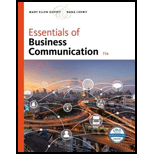
Essentials of Business Communication (MindTap Course List)
11th Edition
ISBN: 9781337386494
Author: Mary Ellen Guffey, Dana Loewy
Publisher: Cengage Learning
expand_more
expand_more
format_list_bulleted
Question
Chapter 11, Problem 11.10AAC
Summary Introduction
Critical think about: The views on work place conflict and group thinking.
Introduction/case summary (question specific)
:
Conflicts are needed in a company. They can lead to better productivity and to avoid miscommunication. They can even solve problems among parties.
Expert Solution & Answer
Trending nowThis is a popular solution!

Students have asked these similar questions
Subject:-- accounting
Provide correct solution and general accounting
Answer
Chapter 11 Solutions
Essentials of Business Communication (MindTap Course List)
Knowledge Booster
Similar questions
- ??!arrow_forwardClearbrook Inc.'s fixed monthly expenses are $28,000 and its contribution margin ratio is 60%. Assuming that the fixed monthly expenses do not change, what is the best estimate of the company's net operating income in a month when sales are $88,000? HELParrow_forwardWhat is the amount of net sales?arrow_forward
- Hello tutor please give answer asap for this accounting problemsarrow_forwardViggo Manufacturing estimates that overhead costs for the next year will be $2,800,000 for indirect labor and $750,000 for factory utilities. The company uses machine hours as its overhead allocation base. If 100,000 machine hours are planned for this next year, what is the company's plantwide overhead rate?arrow_forwardAn asset was purchased for $72,000 with a salvage value of $6,000 on July 1, Year 1. It has an estimated useful life of 6 years. Using the straight-line method, how much depreciation expense should be recognized on December 31, Year 1?arrow_forward
- Please help me solve this general accounting question using the right accounting principles.arrow_forwardWhat is its degree of operating leverage?arrow_forwardA firm reported wages expense of $607 million and cash paid for wages of $578 million. What was the change in wages payable for the period?arrow_forward
arrow_back_ios
SEE MORE QUESTIONS
arrow_forward_ios
Recommended textbooks for you
 Management, Loose-Leaf VersionManagementISBN:9781305969308Author:Richard L. DaftPublisher:South-Western College Pub
Management, Loose-Leaf VersionManagementISBN:9781305969308Author:Richard L. DaftPublisher:South-Western College Pub Understanding Management (MindTap Course List)ManagementISBN:9781305502215Author:Richard L. Daft, Dorothy MarcicPublisher:Cengage Learning
Understanding Management (MindTap Course List)ManagementISBN:9781305502215Author:Richard L. Daft, Dorothy MarcicPublisher:Cengage Learning

Management, Loose-Leaf Version
Management
ISBN:9781305969308
Author:Richard L. Daft
Publisher:South-Western College Pub

Understanding Management (MindTap Course List)
Management
ISBN:9781305502215
Author:Richard L. Daft, Dorothy Marcic
Publisher:Cengage Learning
